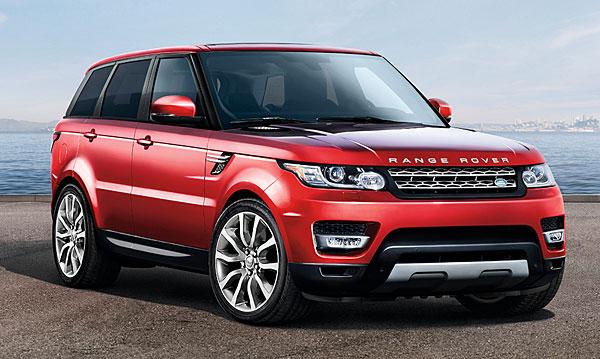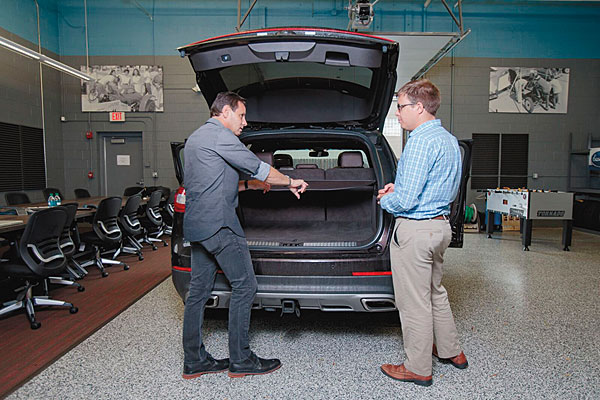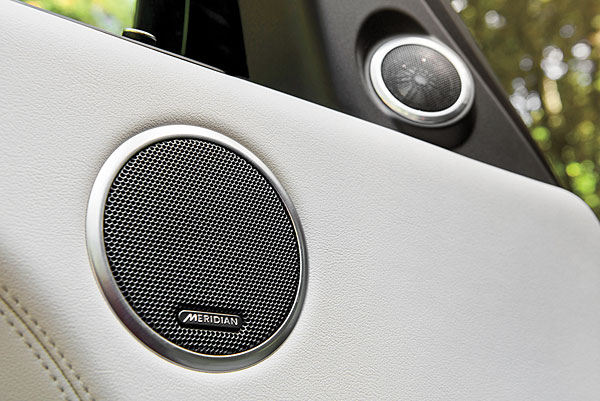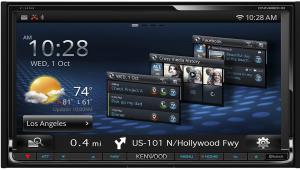Sound On Wheels: Who Makes The Best Luxury Car Audio System?

With this in mind, I excitedly traveled to Detroit last fall to assist our sister publication Automobile in a comparison of OEM car audio systems in eight 2015 and 2016 car models. Working with Automobile’s daily news editor Jake Holmes, who conceived and headed up the project, we spent three days conducting listening tests and informal acoustic measurements on vehicles ranging from a $54,000 Ford Explorer to a $427,000 Bentley Mulsanne. As we quickly found, no two of them sounded alike.
The Tests
An audiophile-quality automotive sound system should accomplish much of what we expect in a great home hi-fi setup, though the car environment offers unique challenges. First, the system ideally needs to present an engagingly wide and three-dimensional soundstage that rides nicely above the dashboard—something that’s harder to do than it sounds. It should have wide frequency range that doesn’t exaggerate or attenuate any part of the sonic spectrum, and good timbral accuracy so instruments and voices sound natural. It requires powerful dynamics to deliver visceral impact on transients (like a drum thwack or plucked string), the ability to reveal detail at both low and loud volume, and enough amplifier headroom to sound unforced even when the system is fighting with everyday road noise. Finally, the car itself needs to be free of distracting rattles or panel resonances excited by the audio system.
To see how the systems compared, we played the same mix of CD music tracks on all the vehicles, listening both in the quiet Automobile test garage and on the same stretches of road at both city and highway speeds (40 mph and 65 mph, respectively). About 10 or 11 tracks ended up in heavy rotation, including a variety of audiophile-quality jazz, classical, pop, and rock recordings that had among them some close-miked male and female vocals. Evaluations were based primarily on the driver-seat experience, though we listened in the passenger and rear seats as well.
Additionally, we played some test tones and made perfunctory measurements using commonly available equipment. We took a baseline frequency response trace of each system’s best-sounding or most “audiophile-like” sound mode using a pink noise test track, an inexpensive calibrated measurement mic, and an iPad Air 2 running the spectrum analyzer from the popular Audio Tools app. We ran a descending low-frequency sweep tone (1,000 hertz to 20 Hz) to get an idea of where each system’s bass response audibly dropped off, and to see if we could excite any rattles or panel resonances.

We also took SPL (sound pressure level) measurements of each car’s baseline road noise at city and highway speeds—with the audio system off—and did a spectrum analysis of the road noise alone in each vehicle, at both driving speeds, to see where its major frequency components sat. It’s worth noting here that although some cars were quieter than others overall, the spectrum analysis revealed that the road noise always had essentially the same frequency component, and it was always in the low end, typically rising in SPL from 120 Hz downward and peaking in the 30-to-60-Hz range. I can’t say this emphatically enough: Road noise kills bass. A system’s ability to overcome this while driving is dependent on how deep and dynamic it is to begin with. But even on the best systems played at any volume, road noise noticeably masked low-frequency detail and impact that was evident in our stationary listening tests. If you want to hear your new car audio system at its best, don’t leave the garage. My observations below are based on our stationary evaluations.
The Systems
Here are the systems, presented as we ranked them. For each car, I’ve indicated the sticker price, who built the audio system, and whether it was included as standard for the designated trim package or subject to an upcharge. You can read more in Automobile’s April issue or on automobilemag.com.
No. 8: Ford Explorer, $55,915; 12-speaker Sony Audio System (standard on Platinum trim)
Jake selected this Explorer to give us a read on a typical “premium” system in a more affordable vehicle. But its failure was not in its simplicity, but rather in Sony’s decision to include poorly executed and, unfortunately, undefeatable spatial processing. Neither the Surround mode nor the alternate Stereo mode was absent to some degree of phasey, reverberant artifacts. Additionally, soundstaging was poor compared with the competition—in either mode, lead vocals appeared just left of center and barely above the dash for the driver, but the front passenger always heard it coming out of the nearby right-side pillar. The system had reasonably good detail reproduction on the mids and highs but lacked any deep bass or real dynamic impact, and we found an exceptionally loud and nasty panel resonance in the driver’s door that vibrated badly when excited by a 60-Hz tone.
No. 7: Infiniti QX80 AWD, $89,845; 13-speaker Bose Premium Audio System (standard)
Although all the systems had adjustments for bass and treble (in some cases, multiband EQ), this was the only place we reached for them. It took no time at all to start cranking on the treble in an attempt to restore the obviously missing high-frequency detail, sparkle, and openness found in the better systems. This somewhat darker voicing may have been intentional to mask the potential harshness of poor-quality radio broadcasts or low-res Internet streams/MP3s, but it took all the magic out of my favorite classic audiophile recordings. For example, “Take the A Train,” a superbly natural and startlingly dynamic recording by Bill Berry and His Ellington All-Stars (from the album For Duke), suffered muted horns, a lack of air around the instruments, and virtually no detail at all in the fine brushed cymbals. Bass response went reasonably low in this system, tailing off around 40 Hz or so in our tone sweeps, but it lacked the transient impact of the best.
No. 6: Mercedes S550 4Matic, $125,525; 13-speaker Burmester Surround Sound
System (standard)
Given the cost of this opulent sedan and a system by the respected Burmester brand out of Germany, I expected an audiophile sensibility. And we got it—kind of. The system had nicely extended frequency response and natural timbre from the mids to highs, and though it lacked the very deep and impactful bass response of our best contenders (dropping off around 45 Hz in our sweeps), it still delivered a full, rich sound. This was also, by a noticeable margin, the quietest of the cars we tested, topping out at 82 decibels at highway speed, while most of the other interiors suffered more than 90 dB of background road noise.
Its Achilles’ heel, for me at least, was its soundstaging, which presented each front-seat listener with their own compressed left-to-right stage rather than a single continuous soundstage atop the dash. There was little space between instruments, shortened front-to-back depth (a challenge to begin with in the car environment), and an unnatural forcing of tight vocals toward the listener’s face. The big, close-miked ballad “Stand Me Up” by singer-songwriter Micah Sheveloff from the album Exhibitionist normally comes off with a thrilling intimacy that puts the singer in the room with you, but here he was uncomfortably close to my nose and emanating from the dashboard at chest height. Flipping on Surround mode brought the stage up only a bit higher. Some might like the presentation, but this isn’t a system I’d personally want to listen to every day.
No. 5: Acura RLX, $66,870; Krell 14-speaker Premium Audio System (standard on Advance trim)
This Krell system was mostly extraordinary. It had great natural timbre and extremely wide frequency range, including some of the most impactful bass of any system—we measured usable response in the 30-to-35-Hz area, and, critically, it had serious transient response that gave drum thwacks from the dynamic Sheffield Drum Record a visceral leading edge and rich decay. The staging put instruments and voices in a wide arc above the dash and delivered excellent space around them, and the DTS Neural mode was effective in improving depth on orchestral recordings without adding offensive artifacts (though it widened lead vocalists somewhat unnaturally).
What kept the system from ranking higher were its door-mounted, magnesium-cone tweeters, custom drivers that contributed to the system’s remarkable clarity and transparency but also tended to localize highs to the speaker, regularly drawing the listener’s attention away from the otherwise cohesive soundstage. They could also be exceptionally revealing of recording quality, which was great with our better tracks but could move into occasional brashness on some recordings. Too bad, because this really was otherwise among the best of the lot and got my audiophile juices flowing.
No. 4: Volvo XC90 TC AWD, $66,705; 19-speaker Bowers & Wilkins Premium Sound System ($2,500 upgrade)
We’re moving now into systems with no immediately detectable flaws, and it’s hard to overstate the all-around excellence of this B&W system. The number of times I used the word clean in my listening comments with regard to different music tracks speaks to its authority and lack of distortion. Bass was deep and tuneful (falling off around 35 Hz on our sweep), and the system played loud with ease and delivered mid- and high-frequency detail without ever going shrill. The high-register solo violin that opens Amanda Marshall’s “The Gyspsy” (from Everybody’s Got a Story) was a torture test the B&W passed with flying colors.
The soundstage presentation was always wide open and up top in true audiophile tradition (though I’d stay away from the reverberant Gothenburg concert hall mode). Note that the system lacked a CD player, requiring us to pump lossless rips of our test tracks into the Aux input from my Macbook via a Sony PHA-2 portable DAC, which gave the system an exceptional source. But with a decent hi-res portable player or high-quality digital music on my smartphone, I could happily climb into this car every morning.
No. 3: Bentley Mulsanne, $427,400; 20-
speaker Naim for Bentley Audio System ($8,030 upgrade)
The pricey audio system in this expensive coach was so good that Jake and I decided to look past the one unforgivable sin we detected in our test vehicle: a loose rear package tray (leather-wrapped plastic, we surmised) that rattled noticeably when excited by sustained bass notes somewhere in the 50-to-100-Hz range. It’s clearly something the folks at Naim never signed off on, and something I’d expect a Bentley dealer would set a team of 40 white-coated minions to correct if you sent your chauffeur in to have it fixed. At least, they ought to.
That said, this system was quite engaging, with an incredibly wide and open soundstage above the dash (we slightly preferred the Balanced listening mode), remarkable dynamic build you could discern easily in orchestral swells and vocal changes, and transparent, distortion-free mids and highs. Its detailed bass went low and had solid transient impact, but if the system had a sonic flaw (and I’m reaching here), it lacked that last bit of bottom-end depth you’d like to feel in the chest and that some of the competition delivered. On the plus side, this was (not surprisingly) among the best-sounding systems from the back seat when set to Rear listening mode.
No. 2: Lincoln MKX Black Label AWD, $67,020; 19-speaker Revel Ultima Audio System (standard on Black Label or included with $4,400 Luxury Package upgrade)
This 19-speaker system from Harman’s high-end Revel brand made everything sound great. I’d call its overall sonic character open and analytical in the best sense of that word, where you can hear into the music and pluck out instrumental lines and fine textural details but without it ever sounding bright or edgy. It revealed all the musical detail in my audiophile recordings across the entire frequency spectrum, excelling against the competition in the bass region, where it went low and had exceptional dynamic leading-edge impact and decay reproduction on things like the Sheffield Drum Record and orchestral tympani strikes. Mids and highs floated transparently in an absolutely huge soundstage above the dash that was really only rivaled by the Naim and the Range Rover Meridian systems (see below), if at all. In short, the Revel system delivered a classic home audiophile experience on wheels.

No. 1: Land Rover Range Rover Sport, $92,347; 23-speaker Meridian Signature Audio System ($3,250 upgrade)
Given the fine competition here and how eminently listenable those systems proved, it’s hard to find fresh vocabulary to explain why this Meridian-built system rose to the top. But it was a favorite from the moment we stepped into the car early in our auditions and remained the one to beat. The 2D Meridian mode delivered a classic audiophile soundstage, and the system was incredibly smooth and clean in its delivery; free of strain no matter how complex the music or how loud it played. Bass had a visceral quality and was extremely tuneful and satisfying, never thumpy. Every last bit of detail in piano notes, guitar plucks, horn blasts—whatever—revealed itself with sharp precision and inner texture, presented in its own space high above the dashboard.
All of the top four systems had that special quality that makes you want to dive into your stack of discs and pull out more and more of your favorites, just to see how they’ll fare and find whether you’ll somehow hear them anew. But, for whatever reason, the Range Rover Meridian system had a little more of that secret sauce. After the audition, I commented that any one of us would be lucky to have a system like this in our home, much less in our car. I can’t think of much higher praise.














































